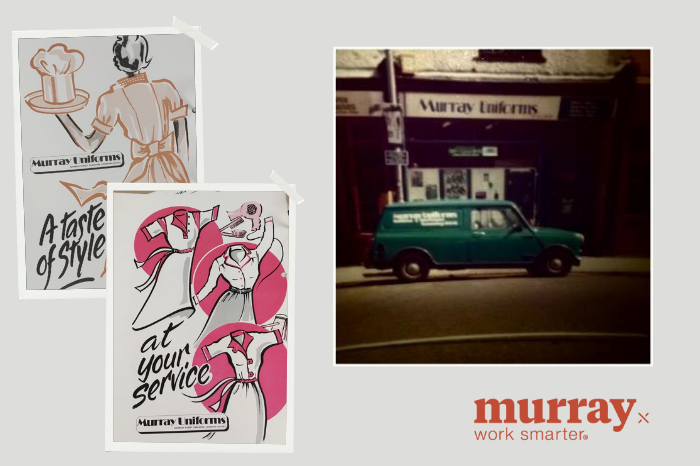Insights with Andy Bass: The heritage and trust behind Murray Uniforms
This is the first of a three-part interview series with Andy Bass, Business Development & ESG Director at Murray Uniforms.
In Chapter 1, we dive into the rich heritage of Murray Uniforms and trace its roots back to the post-World War era, when Andy’s grandfather laid the foundation for what would become a leading name in corporate workwear.
This series will explore the journey and insights of Murray Uniforms, with each chapter released weekly. We will uncover various aspects of the company’s unwavering commitment to trust, quality, and innovation.
Chapter 1: The Foundations of Trust
Let’s start with a brief introduction to Murray Uniforms. Your company has a rich heritage, starting with your grandfather. Can you tell us about the company’s beginnings?
Certainly. My Grandfather founded what would become Murray Uniforms after WW1 in 1918. He had served throughout World War I and, like many others, struggled to find employment afterward. His uncle, who owned a gents outfitter shop, offered him a job, and he gladly accepted as he just needed work. My grandfather quickly learned the tailoring trade and discovered he enjoyed it. Over the next ten years, he became skilled in tailoring.
Never Miss a Retail Update!An interesting twist occurred around that time. The Bedfordshire, Northamptonshire, and Warwickshire areas were home to many country houses with the landed gentry. These individuals would visit the gents outfitter shop for their suits, shooting gear, or evening wear. My grandfather noticed they felt somewhat uncomfortable coming into the shop, so he began offering to visit them instead. This approach really took off, and ten years after he started, he left his uncle’s business to create his own. He spent the rest of his life visiting these country houses, measuring up clients, showing them fabric patterns, and fitting their garments. It was a great life for him, and this personal touch became a hallmark of our business.

That’s a wonderful story. How has the company evolved from those early days?
The company has seen significant changes. My father joined the business part-time while working in a large industry, now known as Alstom, where he had risen to director level. He learned the tailoring trade from my grandfather and, in the early 1970s, saw an opportunity in the burgeoning security industry. He bravely decided to focus on manufacturing and supplying security uniforms, despite the economic challenges of the mid-1970s in the UK. This decision marked the beginning of Murray Uniforms’ transition from traditional tailoring to corporate workwear.
Our first corporate bespoke assignment came from a company my father had previously worked for. They needed specially designed coats for a specific factory area, and we took on the challenge. This success paved the way for further growth in the corporate sector, and we’ve continued to evolve and innovate since then.
How did you personally join the business and what was your training like?
I’ve been with Murray Uniforms for my entire career, joining the company in 1979. In my first couple of years, I was also undergoing training to earn my pattern cutter certificate and my tailoring certificate. This training was crucial because pattern cutting involves designing a pattern that fits well and considers different body shapes and technical aspects of garment construction. Back in those days, we used card and graphite for pattern making, which required a lot of skill to create precise curves by hand. Today, much of that process is done electronically using CAD systems, which has significantly improved precision and efficiency.
And today, how does Murray Uniforms operate in terms of size and scale?
Today, Murray Uniforms is a large-scale operation, with significant growth particularly since 2009. We’ve seen a steady trajectory of 30% year-on-year growth since 2015, which speaks to our robust market offering and strategic planning.
The business and the industry have evolved significantly, from paper cutting to using AI today. What has that evolution looked like, and how has it changed your operations?
The evolution from paper cutting to AI has been transformative. When I started, everything was done manually. The skill of a pattern cutter was judged by how well they could create precise curves by hand. Today, we use CAD systems for pattern design which has allowed us to create more complex designs with greater precision and has streamlined our production processes. Moreover, AI is beginning to play a role in predicting trends, optimising inventory, and even customising fit for individual body types. This technology enables us to be more responsive to customer needs and market changes, enhancing our ability to deliver high-quality, bespoke uniforms efficiently.
You mentioned the concept of “enclothed cognition” and performance. Can you elaborate on that?
Enclothed cognition refers to the impact that clothing has on a person’s psychological state and performance. Research by Hajo Adam and Adam Galinsky has shown that clothing can influence our thoughts and behaviour. Their studies suggest that enclothed cognition effects depend on two conditions: the symbolic meaning of the clothing and actually wearing the clothes.
For example, in one study, students who wore a white coat they believed was a scientist’s lab coat performed significantly better on attention tasks than those who wore their regular clothes. This phenomenon was demonstrated in the Stroop Test, where students wearing the “scientist’s coat” made half as many errors. This highlights how uniforms can enhance focus and performance by influencing the wearer’s mindset.
Join us next week as we share more insights on the cost of ownership and sustainability in corporate uniforms
[FREE EVENT] Register for Murray Uniforms upcoming event High Trust Organisations: Recipe for Success to learn more about building trust in your organisation.













